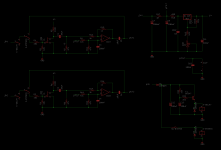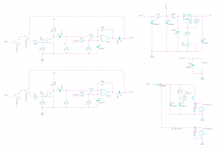If you don't have matching then you probably rely on individually tested
Source resistors to equalize the current.
Source resistors to equalize the current.
They vary wildly...to match 1000 would require several thousands. Not appealing.
I have few hundred of j113 and j176 and was able to match octets and make a nice headphone amp. That's easily doable.
I have few hundred of j113 and j176 and was able to match octets and make a nice headphone amp. That's easily doable.
I have been requested by one of the members (Carston.Witt) for the
Gerbers to the H2 board that was distributed at BAF, this for the purpose
of making them for a small group of DIYers in Europe.
Here they are, everyone is welcome to play with them.
Since they require matched Jfets, we will have to make some provision
for supplying those as well.

Gerbers to the H2 board that was distributed at BAF, this for the purpose
of making them for a small group of DIYers in Europe.
Here they are, everyone is welcome to play with them.
Since they require matched Jfets, we will have to make some provision
for supplying those as well.

Attachments
Last edited:
I have been requested by one of the members (Carston.Witt) for the
Gerbers to the H2 board that was distributed at BAF, this for the purpose
of making them for a small group of DIYers in Europe.
Here they are, everyone is welcome to play with them.
Since they require matched Jfets, we will have to make some provision
for supplying those as well.

Any chance of a kit run for the diyAudio store?
For the upcoming Burning Amp Festival I created a nice little 2nd Harmonic
Generator. It's similar to what the Korg Nutube does, but uses a Jfet.
The DIY store already offers kits for the B1 with Korg Triode. If a kit for the H2 is realized, would you expect a material difference in the resulting sound?
Or does the B1 add the benefits of a buffer in addition to "tube" sound?
Just trying to understand the decision process a potential purchaser would have choosing between the two if the challenges of sourcing components are resolved by the DIY Store.
The H2 is simpler and much cheaper, but offers a similar effect with only 1 Fet per
channel. Both have gain, high impedance, low output impedance.
You are expected to get them both. 😉
channel. Both have gain, high impedance, low output impedance.
You are expected to get them both. 😉
You are expected to get them both. 😉
I have no problem with that! 😀
FYI
Just posted in the Class aP amplification thread a circuit which generates harmonics H2 H3..etc. The signal FFT looks like that from the H2 device.
Just posted in the Class aP amplification thread a circuit which generates harmonics H2 H3..etc. The signal FFT looks like that from the H2 device.
Sanity check
I've put together a circuit incorporating Mr Pass's H2 generator followed by an inverting stage plus delay and bypass relays.
I stayed with the lone 24V input, so the op amp is running in single supply configuration.
How does this look? Any dumb mistakes?

Feel free to suggest changes 😀. Once it's solid I'll post the gerbers here.
I've put together a circuit incorporating Mr Pass's H2 generator followed by an inverting stage plus delay and bypass relays.
I stayed with the lone 24V input, so the op amp is running in single supply configuration.
How does this look? Any dumb mistakes?

Feel free to suggest changes 😀. Once it's solid I'll post the gerbers here.
Hi, I worry that in "bypass" mode you might have a deadly fight because the input to your box is shorted to the output of your box. If the input is from your phono preamp then it's fighting against the output pin of opamp U1.
Also you might prefer to connect R7 to (VFILT / 2) instead of to ground.
Inverse color palette (white blackground) image attached
Also you might prefer to connect R7 to (VFILT / 2) instead of to ground.
Inverse color palette (white blackground) image attached
Attachments
Thank you for the input Mark 🙂
Okay, I'll add a relay for the output as well.
Would a simple resistor divider do the job?
Hi, I worry that in "bypass" mode you might have a deadly fight because the input to your box is shorted to the output of your box.
Okay, I'll add a relay for the output as well.
Also you might prefer to connect R7 to (VFILT / 2) instead of to ground.
Would a simple resistor divider do the job?
Also you might prefer to connect R7 to (VFILT / 2) instead of to ground.
Duh, wait, I just realised what you meant 😀. Ignore the last part of my previous post.
Unless I missed reading a few posts, no posts have been related to actual use in a system and or subjective/objective benefits attributed to the H2.
After almost a year, I have finally completed my H2 "build" which included hard wiring the wall wart power supply, replacing the inexpensive RCA jacks with some of better build quality, adding an LED readout of the Output Voltage, putting into a extruced build box. I also fabricated short RCA jumpers for connection between preamp and H2.
Just installed in my system comprised of:
Any assist with diagnosis would be great.
After almost a year, I have finally completed my H2 "build" which included hard wiring the wall wart power supply, replacing the inexpensive RCA jacks with some of better build quality, adding an LED readout of the Output Voltage, putting into a extruced build box. I also fabricated short RCA jumpers for connection between preamp and H2.
Just installed in my system comprised of:
- Mytek Manhattan II DAC;
- Custom built LDR based preamp (similar concept to Tortuga);
- XA60.8 amps;
- Martin Logan CLX Art electrostats;
- HSU VTF-15H MkII subs for stereo bass;
- Velodyne F1200 subwoofer for ambient bass;
- PS Audio P3 powering pre and DAC;
- PS Audio P300 powering electrostats;
- Harmonic Technology Photon interconnects between DAC/pre and pre/amps;
- Anticable Level 5 speaker cables;
Any assist with diagnosis would be great.
If I were in your position, the first two experiments I would probably try, are:
These test results might help narrow down the list of possible reasons for the whine.
- Remove H2 box from audio system. Listen to audio system to discover if whine has disappeared or changed
- Move H2 box to lab bench, install shorting plugs on inputs, connect oscilloscope probe to output(s). Are oscillations / misbehaviors present? Remove shorting plugs and allow inputs to float. Now are oscillations / misbehaviors present?
If I were in your position, the first two experiments I would probably try, are:
These test results might help narrow down the list of possible reasons for the whine.
- Remove H2 box from audio system. Listen to audio system to discover if whine has disappeared or changed
- Move H2 box to lab bench, install shorting plugs on inputs, connect oscilloscope probe to output(s). Are oscillations / misbehaviors present? Remove shorting plugs and allow inputs to float. Now are oscillations / misbehaviors present?
Thanks, I plan to do (1) as a first experiment...but expect NO issue since none before shutdown and no other changes made.
You are assuming I have a "lab" bench, oscilloscope, and shorting plugs!
NO in all cases no resource to outsource.
Sorry to hear it. Those are the steps I would take, in part because I do own the gear. Good luck & best wishes for quick success.
Thanks, I plan to do (1) as a first experiment...but expect NO issue since none before shutdown and no other changes made.
You are assuming I have a "lab" bench, oscilloscope, and shorting plugs!
NO in all cases no resource to outsource.
Talking to myself again...🙄
As expected removing the H2 eliminated the whine.
Question...
With the H2 removed from the system, is there any checks I can do with a multimeter? E.G., with the H2 powered, what should I see, if anything on the meter ...
with probes attached to the RCA input and output +'s?
with probes attached to the RCA input and output -'s?
